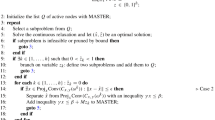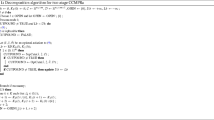Abstract
We propose an algorithm based on infeasible irreducible subsystems to solve binary linear chance-constrained problems with random technology matrix. By leveraging on the problem structure we are able to generate good quality upper bounds to the optimal value early in the algorithm, and the discrete domain is used to guide us efficiently in the search of solutions. We apply our methodology to individual and joint binary linear chance-constrained problems, demonstrating the ability of our approach to solve those problems. Extensive numerical experiments show that, in some cases, the number of nodes explored by our algorithm is drastically reduced when compared to a commercial solver.


Similar content being viewed by others
References
Abdelaziz, F.B., Aouni, B., El Fayedh, R.: Multi-objective stochastic programming for portfolio selection. Eur. J. Oper. Res. 177(3), 1811–1823 (2007)
Abdi, A., Fukasawa, R.: On the mixing set with a knapsack constraint. Math. Program. 157(1), 191–217 (2016)
Ahmed, S., Papageorgiou, D.J.: Probabilistic set covering with correlations. Oper. Res. 61(2), 438–452 (2013)
Beasley, J.E.: An algorithm for set covering problem. Eur. J. Oper. Res. 31(1), 85–93 (1987)
Beraldi, P., Ruszczyński, A.: The probabilistic set-covering problem. Oper. Res. 50(6), 956–967 (2002)
Campi, M.C., Garatti, S.: The exact feasibility of randomized solutions of uncertain convex programs. SIAM J. Optimiz. 19(3), 1211–1230 (2008)
Campi, M.C., Garatti, S., Prandini, M.: The scenario approach for systems and control design. Annu. Rev. Control 33(2), 149–157 (2009)
Charnes, A., Cooper, W.W., Symonds, G.H.: Cost horizons and certainty equivalents: an approach to stochastic programming of heating oil. Manag. Sci. 4(3), 235–263 (1958)
Chinneck, J.W.: Feasibility and infeasibility in optimization: algorithms and computational methods, vol. 118. Springer, Berlin (2007)
Dentcheva, D., Prékopa, A., Ruszczynski, A.: Concavity and efficient points of discrete distributions in probabilistic programming. Math. Program. 89(1), 55–77 (2000)
Gleeson, J., Ryan, J.: Identifying minimally infeasible subsystems of inequalities. ORSA J. Comput. 2(1), 61–63 (1990)
Küçükyavuz, S.: On mixing sets arising in chance-constrained programming. Math. Program. 132(1–2), 31–56 (2012)
Kumral, M.: Application of chance-constrained programming based on multi-objective simulated annealing to solve a mineral blending problem. Eng. Optimiz. 35(6), 661–673 (2003)
Lejeune, M., Noyan, N.: Mathematical programming approaches for generating p-efficient points. Eur. J. Oper. Res. 207(2), 590–600 (2010)
Lejeune, M.A.: Pattern-based modeling and solution of probabilistically constrained optimization problems. Oper. Res. 60(6), 1356–1372 (2012)
Luedtke, J., Ahmed, S.: A sample approximation approach for optimization with probabilistic constraints. SIAM J. Optimiz. 19(2), 674–699 (2008)
Pagnoncelli, B., Ahmed, S., Shapiro, A.: Sample average approximation method for chance constrained programming: theory and applications. J. Optimiz. Theory Appl. 142(2), 399–416 (2009)
Prékopa, A.: Dual method for the solution of a one-stage stochastic programming problem with random rhs obeying a discrete probability distribution. Z. Oper. Res. 34(6), 441–461 (1990)
Saxena, A., Goyal, V., Lejeune, M.A.: Mip reformulations of the probabilistic set covering problem. Math. Program. 121(1), 1–31 (2010)
Song, Y., Luedtke, J.R., Küçükyavuz, S.: Chance-constrained binary packing problems. INFORMS J. Comput. 26(4), 735–747 (2014)
Tanner, M.W., Ntaimo, L.: IIS branch-and-cut for joint chance-constrained stochastic programs and application to optimal vaccine allocation. Eur. J. Oper. Res. 207(1), 290–296 (2010)
Zhu, M., Taylor, D.B., Sarin, S.C., Kramer, R., et al.: Chance constrained programming models for risk-based economic and policy analysis of soil conservation. Agric. Resour. Econ. Rev. 23(1), 58–65 (1994)
Author information
Authors and Affiliations
Corresponding author
Additional information
Publisher's Note
Springer Nature remains neutral with regard to jurisdictional claims in published maps and institutional affiliations.
Pagnoncelli and Canessa thank the support of Anillo Grant ACT 1407 and Piensa Mineria 2018 Grant.
Rights and permissions
About this article
Cite this article
Canessa, G., Gallego, J.A., Ntaimo, L. et al. An algorithm for binary linear chance-constrained problems using IIS. Comput Optim Appl 72, 589–608 (2019). https://doi.org/10.1007/s10589-018-00055-9
Received:
Published:
Issue Date:
DOI: https://doi.org/10.1007/s10589-018-00055-9




